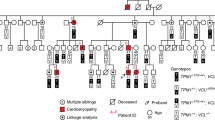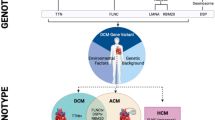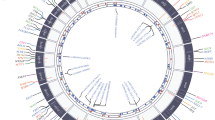Abstract
Dilated cardiomyopathy (DCM) is a heart muscle disease characterized by impaired contractility and dilation of the ventricles. In a subset of DCM patients, classical inheritance patterns occur (familial DCM), which have led to the identification of specific genomic loci and gene defects causing monogenic DCM subtypes. In the majority of DCM patients, however, there is no evidence for a monogenic etiology of the disorder (sporadic DCM), and in the absence of other recognizable etiological factors, these cases were classified as “idiopathic”. Recent research suggests that cardiotropic viruses are important environmental factors in the pathogenesis of “idiopathic” cases and that DCM commonly results from interactions between genetic and environmental factors, whereas “pure” genetic forms are rather rare. Regarding genetics, the clinical cardiomyopathic phenotype associated with single gene defects may be highly variable for unknown reasons. Furthermore, a novel class of genetic defects was identified recently which provide a molecular basis for abnormal reactions of cardiomyocytes to environmental stress. These defects are paradigms of specific molecular links between genome and environment during the pathogenesis of DCM. Regarding environmental factors, a recent molecular virological study based on myocardial biopsies in a large series of sporadic DCM patients has detected cardiac viral infections in the majority of patients, with a broad spectrum of virus species being involved. Apparently, DCM does not only occur as a late sequela of acute viral myocarditis, but also in patients without clinical history of cardiac viral disease. Cardiotropic viruses thus emerge as prevalent environmental factors which may cause or influence the course of DCM in a large fraction of cases. Synopsis of current data suggests that a comprehensive picture of DCM pathogenesis can only be drawn if both genetic and environmental pathogenetic factors are considered. The course of cardiac viral infections depends strongly on genetic host factors and may range from rapid and complete virus elimination or silencing without clinical symptoms, to rapidly progressive or fatal disease. Viruses interact not only with genetically heterogenous host systems of virus uptake, migration, and antiviral immunity, but, due to their prevalence in DCM hearts, are also likely to encounter multiple structural proteins of cardiac cells known to be defective in familial DCM. The combined knowledge on DCM-associated gene defects and viruses therefore suggests in-depth studies on genome–environment interactions in DCM pathogenesis which may underlie the high clinical variability observed both in monogenic and virus-associated DCM and have implications for the clinical management of DCM patients.

Similar content being viewed by others
Abbreviations
- AdV:
-
adenovirus
- ATD:
-
α1-antitrypsin deficiency
- CAR:
-
coxsackievirus–adenovirus receptor
- CMV:
-
cytomegalovirus
- COPD:
-
chronic obstructive pulmonary disease
- CVB3:
-
coxsackievirus B3
- DAF:
-
decay accelerating factor
- DCM:
-
dilated cardiomyopathy
- EBV:
-
Epstein–Barr virus
- EV:
-
enteroviruses (coxsackieviruses and echoviruses)
- HCM:
-
hypertrophic cardiomyopathy
- HCV:
-
hepatitis C virus
- HHV6:
-
human herpes virus 6
- InfA/B:
-
Influenza virus A/B
- INFβ:
-
interferon-β
- MLP:
-
muscle LIM protein
- NBC:
-
nuclear pore complex
- PVB19:
-
parvovirus B19
- RCM:
-
restrictive cardiomyopathy
- TLR:
-
toll-like receptor
References
Eriksson S (1964) Pulmonary emphysema and α1-antitrypsin deficiency. Acta Med Scand 175:197–205
Crystal R (1990) α1-antitrypsin deficiency, emphysema, and liver disease. J Clin Invest 85:1343–1352
Poller W, Faber J-P, Olek K (1990) Highly variable clinical course in severe α1-antitrypsin deficiency—use of polymerase chain reaction for the detection of rare deficiency alleles. Klin Wochenschr 68:857–863
Stecenko A, Brigham K (2003) Gene therapy progress and prospects: α1 antitrypsin. Gene Ther 10:95–99
Eriksson S, Carlson J, Veley R (1986) Risk of cirrhosis and primary liver cancer in α1-antitrypsin deficiency. N Engl J Med 314:736–739
Teckman J, Qu D, Perlmutter D (1996) Molecular pathogenesis of liver disease in α1-antitrypsin deficiency. Hepatology 24:1504–1516
Wu Y, Whitman I, Molmenti E, Moore K, Hippenmeyer P, Perlmutter D (1994) A lag in intracellular degradation of mutant α1-antitrypsin correlates with the liver disease phenotype in homozygous PI ZZ α1-antitrypsin deficiency. Proc Natl Acad Sci U S A 91:9014–9018
Franz W, Muller O, Katus H (2001) Cardiomyopathies: from genetics to the prospect of treatment. Lancet 358:1627–1637
Sylvius N, Duboscq-Bidot L, Bouchier C et al (2003) Mutational analysis of the β- and δ-sarcoglycan genes in a large number of patients with familial and sporadic dilated cardiomyopathy. Am J Med Genet 120A:8–12
Sebillon P, Bouchier C, Bidot L et al (2003) Expanding the phenotype of LMNA mutations in dilated cardiomyopathy and functional consequences of these mutations. J Med Genet 40:560–567
Mogensen J, Murphy R, Shaw T et al (2004) Severe disease expression of cardiac troponin C and T mutations in patients with dilated cardiomyopathy. J Am Coll Cardiol 44:2033–2040
Kärkkäinen S, Heliö T, Miettinen R et al (2004) A novel mutation, Ser143Pro, in the lamin A/C gene is common in Finnish patients with familial dilated cardiomyopathy. Eur Heart J 25:885–893
Gomes A, Potter J (2004) Molecular and cellular aspects of troponin cardiomyopathies. Ann N Y Acad Sci 1015:214–224
Mogensen J, Kubo T, Duque M et al (2003) Idiopathic restrictive cardiomyopathy is part of the clinical expression of cardiac troponin I mutations. J Clin Invest 111:209–216
Murphy R, Mogensen J, Shaw A, Kubo T, Hughes S, McKenna W (2004) Novel mutation in cardiac troponin I in recessive idiopathic dilated cardiomyopathy. Lancet 363:371–372
Brito D, Richard P, Isnard R, Pipa J, Komajda M, Madeira H (2003) Familial hypertrophic cardiomyopathy: the same mutation, different prognosis. Comparison of two families with a long follow-up. Rev Port Cardiol 22:1445–1461
Knöll R, Hoshijima M, Hoffman H et al (2002) The cardiac mechanical stretch sensor machinery involves a Z disc complex that is defective in a subset of human dilated cardiomyopathy. Cell 111:943–955
Mahon N, Madden B, Caforio A et al (2002) Immunohistologic evidence of myocardial disease in apparently healthy relatives of patients with dilated cardiomyopathy. J Am Coll Cardiol 39:455–462
Bowles N, Richardson P, Olsen E, Archard L (1986) Detection of coxsackie-B virus-specific RNA sequences in myocardial biopsy samples from patients with myocarditis and dilated cardiomyopathy. Lancet 1:1120–1123
Pauschinger M, Doerner A, Kuehl U et al (1999) Enteroviral RNA replication in the myocardium of patients with left ventricular dysfunction and clinically suspected myocarditis. Circulation 99:889–895
Kühl U, Pauschinger M, Schwimmbeck P et al (2003) Interferon-β treatment eliminates cardiotropic viruses and improves left ventricular function in patients with myocardial persistence of viral genomes and left ventricular dysfunction. Circulation 107:2793–2798
Frustaci A, Chimenti C, Calabrese F, Pieroni M, Thiene G, Maseri A (2003) Immunosuppressive therapy for active lymphocytic myocarditis: virologic and immunologic profile of responders versus non-responders. Circulation 107:857–863
Bowles N, Towbin J (2000) Molecular aspects of myocarditis. Curr Infect Dis Rep 2:308–314
Kühl U, Pauschinger M, Bock T et al (2003) Parvovirus B19 infection mimicking acute myocardial infarction. Circulation 108:945–950
Bültmann B, Klingel K, Sotlar K et al (2003) Fatal parvovirus B19-associated myocarditis clinically mimicking ischemic heart disease: an endothelial cell-mediated disease. Human Pathol 23:92–95
Kühl U, Pauschinger M, Noutsias M et al. High prevalence of viral genomes and multiple viral infections in the myocardium of adults with “idiopathic” left ventricular dysfunction. Circulation, in press
Richardson P, McKenna W, Bristow M et al (1996) Report of the 1995 World Health Organization/International Society and Federation of Cardiology Task Force on the definition and classification of cardiomyopathies. Circulation 93:841–842
Dec G, Palacios I, Fallon J et al (1985) Active myocarditis in the spectrum of acute dilated cardiomyopathies. Clinical features, histological correlates and clinical outcome. N Engl J Med 312:885–890
Feldman A, McNamara D (2000) Medical progress: myocarditis. N Engl J Med 343:1388–1398
Rohayem J, Dinger J, Fischer R, Klingel K, Kandolf R, Rethwilm A (2001) Fatal myocarditis associated with acute parvovirus B19 and herpesvirus 6 coinfection. J Clin Microbiol 39:4585–4587
Nigro G, Bastianon V, Colloridi V et al (2000) Human parvovirus B19 infection in infancy associated with acute and chronic lymphocytic myocarditis and high cytokine levels: report of 3 cases and review. Clin Infect Dis 31:65–69
Murry C, Jerome K, Reichenbach D (2001) Fatal parvovirus myocarditis in a 5-year-old girl. Human Pathol 32:342–345
Yoshikawa T, Ihira M, Suzuki K et al (2001) Fatal acute myocarditis in an infant with human herpesvirus 6 infection. J Clin Pathol 54:792–795
Pankuweit S, Moll R, Baandrup U, Portig I, Hufnagel G, Maisch B (2003) Prevalence of the parvovirus B19 genome in endomyocardial biopsy specimens. Human Pathol 94:497–500
Klingel K, Kandolf R (1993) The role of enterovirus replication in the development of acute and chronic heart muscle disease in different immunocompetent mouse strains. Scand J Infect Dis Suppl 88:79–85
Shioi T, Matsumori A, Sasayama S (1996) Persistent expression of cytokine in the chronic stage of viral myocarditis in mice. Circulation 94:2930–2937
Horwitz M, LaCava A, Fine C, Rodriguez E, Ilic A, Sarvetnick N (2000) Pancreatic expression of interferon-γ protects mice from lethal coxsackievirus B3 infection and subsequent myocarditis. Nat Med 6:693–697
Tschöpe C, Bock C, Kasner M et al. High prevalence of cardiac parvovirus B19 infection in patients with isolated left ventricular diastolic dysfunction. Circulation, in press
Noutsias M, Fechner H, Jonge H et al (2001) Human coxsackie-adenovirus-receptor is co-localized with Iintegrins αvβ3 and αvβ5 on the cardiomyocyte sarcolemma and upregulated in dilated cardiomyopathy—implications for cardiotropic viral infections. Circulation 104:275–280
Fechner H, Noutsias M, Tschoepe C et al (2003) Induction of coxsackievirus–adenovirus-receptor expression during myocardial tissue formation and remodeling—identification of a cell–cell contact dependent regulatory mechanism. Circulation 107:876–882
Gaggar A, Shayakhmetov D, Lieber A (2003) CD46 is a cellular receptor for group B adenoviruses. Nat Med 9:1408–1412
Ulevitch R (2004) Therapeutics targeting the innate immune system. Nat Rev Immunol 4:512–520
Liu P, Aitken K, Kong YY et al (2000) The tyrosine kinase p56lck is essential in coxsackievirus B3-mediated heart disease. Nat Med 6:429–434
Deonarain R, Cerullo D, Fuse K, Liu P, Fish E (2004) Protective role for interferon-β in coxsackievirus B3 infection. Circulation 110 (in press)
Opavsky M, Martino T, Rabinovitch M et al (2002) Enhanced ERK-1/2 activation in mice susceptible to coxsackievirus-induced myocarditis. J Clin Invest 109:1561–1569
Badorff C, Lee G, Iamphear B et al (1999) Enteroviral protease 2A cleaves dystrophin: evidence of cytoskeletal disruption in an acquired cardiomyopathy. Nat Med 5:320–326
Xiong D, Lee G-H, Badorff C et al (2002) Dystrophin deficiency markedly increases enterovirus-induced cardiomyopathy: a genetic predisposition to viral heart disease. Nat Med 8:782–877
Eigenthaler M, Engelhardt S, Schinke B et al (2003) Disruption of cardiac Ena-VASP protein localization in intercalated disks causes dilated cardiomyopathy. Am J Physiol Heart Circ Physiol 285:H2471–H2481
Arimura T, Hayashi T, Terada H et al (2004) A Cypher/ZASP mutation associated with dilated cardiomyopathy alters the binding affinity to protein kinase C. J Biol Chem 279:6746–6752
Zemljic-Harpf AE, Ponrartana S, Avalos RT et al (2004) Heterozygous inactivation of the vinculin gene predisposes to stress-induced cardiomyopathy. Am J Pathol 165:1033–1044
Hamada H, Suzuki M, Yuasa S et al (2004) Dilated cardiomyopathy caused by aberrant endoplasmic reticulum quality control in mutant KDEL receptor transgenic mice. Mol Cell Biol 24:8007–8017
Kamisago M, Solomon S, Sharma P et al (2000) Mutations in sarcomere protein genes as a cause of dilated cardiomyopathy. N Engl J Med 343:1688–1696
Bonne G, Carrier L, Richard P, Hainque B, Schwartz K (1998) Familial hypertrophic cardiomyopathy: from mutations to functional defects. Circ Res 83:580–593
Olson T, Michels V, Thibodeau S, Tai Y-S, Keating M (1998) Actin mutations in dilated cardiomyopathy, a heritable form of heart failure. Science 280:750–752
Mogensen J, Klausen IC, Pedersen AK et al (1999) α-cardiac actin is a novel disease gene in familial hypertrophic cardiomyopathy. J Clin Invest 103:R39–R43
Li D, Czernuszewicz GZ, Gonzalez O et al (2001) Novel cardiac troponin T mutation as a cause of familial dilated cardiomyopathy. Circulation 104:2188–2193
Hoffmann B, Schmidt-Traub H, Perrot A, Osterziel KJ, Gessner R (2001) First mutation in cardiac troponin C, L29Q, in a patient with hypertrophic cardiomyopathy. Human Mutat 17:524
Olson T, Kishimoto N, Whitby F, Michels V (2001) Mutations that alter the surface charge of alpha-tropomyosin are associated with dilated cardiomyopathy. J Mol Cell Cardiol 33:723–732
Thierfelder L, Watkins H, MacRae C et al (1994) α-tropomyosin and cardiac troponin T mutations cause familial hypertrophic cardiomyopathy: a disease of the sarcomere. Cell 77:701–712
Gerull B, Gramlich M, Atherton J et al (2002) Mutations of TTN, encoding the giant muscle filament titin, cause familial dilated cardiomyopathy. Nat Genet 30:201–204
Itoh-Satoh M, Hayashi T, Nishi H et al (2002) Titin mutations as the molecular basis for dilated cardiomyopathy. Biochem Biophys Res Commun 291:385–393
Mohapatra B, Jimenez S, Lin JH et al (2003) Mutations in the muscle LIM protein and α-actinin-2 genes in dilated cardiomyopathy and endocardial fibroelastosis. Mol Genet Metab 80:207–215
Tsubata S, Bowles KR, Vatta M et al (2000) Mutations in the human d-sarcoglycan gene in familial and sporadic dilated cardiomyopathy. J Clin Invest 106:655–662
Maeda M, Holder E, Lowes B, Valent S, Bies R (1997) Dilated cardiomyopathy associated with deficiency of the cytoskeletal protein metavinculin. Circulation 95:17–20
Li D, Tapscoft T, Gonzalez O et al (1999) Desmin mutation responsible for idiopathic dilated cardiomyopathy. Circulation 100:461–464
Goldfarb LG, Park KY, Cervenakova L et al (1998) Missense mutation in desmin associated with familial cardiac and skeletal myopathy. Nat Genet 19:402–403
Fatkin D, MacRae C, Sasaki T et al (1999) Missense mutations in the rod domain of the lamin A/C gene as caused of dilated cardiomyopathy and conduction-system disease. N Engl J Med 341:1715–1724
Schmitt J, Kamisago M, Asahi M et al (2003) Dilated cardiomyopathy and heart failure caused by a mutation in phospholamban. Science 299:1410–1413
Haghighi K, Kolokathis F, Pater L et al (2003) Human phospholamban null results in lethal dilated cardiomyopathy revealing a critical difference between mouse and human. J Clin Invest 111:869–876
Forleo C, Resta N, Sorrentino S et al (2004) Association of β-adrenergic receptor polymorphisms and progression to heart failure in patients with idiopathic dilated cardiomyopathy. Am J Med 117:451–458
Mizon-Gerard F, de Groote P, Lamblin N et al (2004) Prognostic impact of matrix metalloproteinase gene polymorphisms in patients with heart failure according to the aetiology of left ventricular systolic dysfunction. Eur Heart J 25:688–693
Acknowledgements
This publication has been supported by the Deutsche Forschungsgemeinschaft through Sonderforschungsbereich/Transregio 19.
Author information
Authors and Affiliations
Corresponding author
Rights and permissions
About this article
Cite this article
Poller, W., Kühl, U., Tschoepe, C. et al. Genome–environment interactions in the molecular pathogenesis of dilated cardiomyopathy. J Mol Med 83, 579–586 (2005). https://doi.org/10.1007/s00109-005-0664-2
Received:
Accepted:
Published:
Issue Date:
DOI: https://doi.org/10.1007/s00109-005-0664-2




